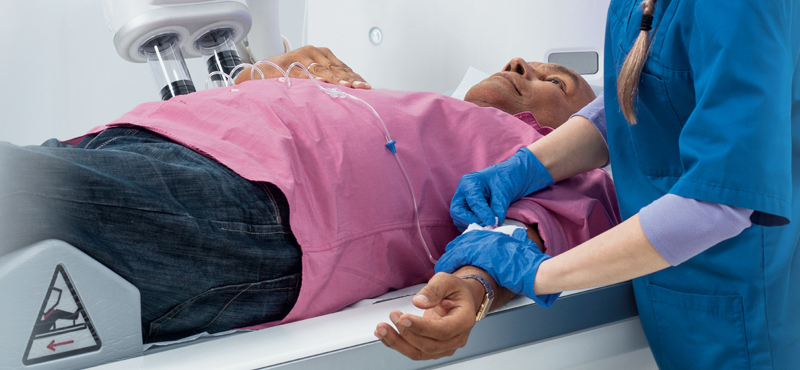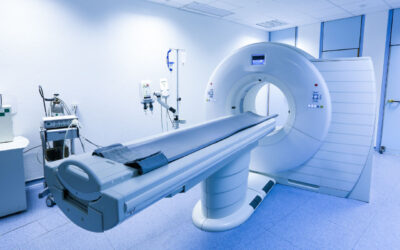
Sometimes, change feels like the only constant in the world of health care, and nowhere moreso than in the context of Medicare reimbursement payments. In the world of medical imaging, the tug-of-war over rate reductions is a source of constant contention in an industry that battles the competing impulses of operational expenses and quality of service. Fallout from the latest edition in this ongoing saga moved to the forefront of discussion in January, as the latest in a series of reductions managed by the Centers for Medicare and Medicaid Services (CMS) took effect.
In April 2014, the federal government passed compliance legislation designed to make all health care providers meet the XR-29 standard published by the National Electrical Manufacturers Association (NEMA) for dose optimization and management of computed tomography (CT) scanners. Proposed implementation rules followed from CMS, and by January 2016, providers whose CT equipment is out of compliance with the XR-29 standard were subject to a 5 percent per-scan reimbursement reduction. Effective January 1, 2017, that reduction was increased threefold, to 15 percent per scan.
Radiology provisions in the 2016 consolidated appropriations act – the mechanism whereby Congress determines federal funding for fiscal 2017 – counteracted these penalties somewhat, after a proposed 25 percent cut in the professional component multiple procedure payment reduction (PC MPPR) only took effect as a 5 percent cut. However, in exchange, analog X-ray reimbursements are now subject to a 20 percent reimbursement rate reduction in 2017 and beyond, and CR procedures will absorb a 7 percent cut from 2018 to 2022 and a 10 percent reduction in 2023 and thereafter. According to a February 2016 report from the Advisory Board, there may be upwards of 8,000 CR X-ray machines still in use.

Laurie Schachtner
Director of the Imaging and Cancer Center at Presence Saint Joseph Hospital
Laurie Schachtner, who directs the Imaging and Cancer Center at Presence Saint Joseph Hospital of Elgin, Illinois, said that in order to counteract any loss of revenue from reimbursement reductions, organizational leaders should rely on fundamental business strategies, including comprehensive, short-term, and long-range planning.
“You’ve got to be creative, business-like, and be prepared,” Schachtner said. “I made a strategic capital plan – 2017-2018, inclusive of specific quarters – for phasing out the specific analog Radiology Rooms/Portables into digital (full-room replacement versus retrofit) in order to minimize the reduction of reimbursement until we can get them all digital.”
When capital budgets are established months and years in advance, all equipment purchases must typically be requested, which requires commitment to a forecasting process that is by no means standard at every organization. The more strategic and prepared a system can be in planning for such purchases into its strategic capital budget, however, the less stressful the process becomes for the imaging department, Schachtner said. Yet even with the “cash cow” of outpatient reimbursement dollars on the table, capital purchasing is still subject to the same organizational priorities – financial competition, dwindling revenues, adjustments in lines of service – that can complicate acquisitions.
“You’ve got to be a good businessperson, an advocate, and do your research,” Schachtner said. “There are so many competing expenses. We’re all fighting for a fixed amount of dollars. Imaging leaders must perform due diligence to figure out what they really need and be good stewards. Do the work beforehand, and map out all of the numbers.”
When replacing equipment, Schachtner recommends performing business volume and capacity analyses for each proposed replacement piece to ensure the most appropriate use of resources are being requested. Instead of pushing for a one-for-one technology swap-out, replacing every analog X-ray machine with a digital counterpart, she said assets should be managed according to patient demand, scheduling and volumes.
“The reimbursement reduction with digital equipment really does make you prioritize as far as how many radiology machines or rad rooms you really need,” Schachtner said. “Just because I have three analog radiology machines or rad rooms currently does not necessarily mean that I will need three digital machines or rooms to replace them.”
“There are so many competing expenses. We’re all fighting for a fixed amount of dollars. Imaging leaders must perform due diligence to figure out what they really need and be good stewards. Do the work beforehand, and map out all of the numbers.”
Schachtner’s strategic plan compares the current and planned future states of her hospital’s imaging technology inventory with the aims of balancing major purchases against other competing expenses. Short of that, she said, other traditional cost-cutting measures simply aren’t available to her.
“I cannot possibly cut staffing any more than I have,” she said. “We have been paring down rad staff within all modalities and imaging support functions over the past four years. We are cut to the bone.”
At a system level, Schachtner sees that many hospital groups are so preoccupied with sustaining their current-year financial operations that the idea of future forecasting may not be in the plan. Oddly, she said, the fiscal disincentive can help things somewhat by taking internal politics out of the in-house process.
“I’m glad for the reduction because that gets us the equipment we need,” Schachtner said. “Digital imaging is qualitatively superior over analog. The patient obtains the best diagnosis in the most expedient fashion with a cost-effective modality for the imaging study. Isn’t the goal for future health care all about high quality in the most cost-effective manner?
“Direct Digital imaging is amazing for clinical quality,” she said. “It’s life-saving. It needs to be there in medicine. Radiology touches ER, OR, inpatient, and outpatient [lines of service]. This is the best thing you can do in medicine to help quality and acuity. If we’re talking about having fewer heads in the beds, this is the right thing to do.”
When performance metrics are based on throughput as well as quality of care, rate reductions don’t only have a budgetary impact; they can affect the patient experience as well. It’s a familiar refrain in a national health care system that is still focused on delivering value-based care, said Alan Moretti, Vice President of Healthcare Technology Management for Renovo Solutions.

Alan Moretti
Vice President of Healthcare Technology Management for Renovo Solutions
Moretti said there’s a segment of the industry that has responded to these financial penalties as “forced technology advancement,” but another segment who shares Schachtner’s view that they’re also rightly about process improvement and patient safety. Technical improvements around dose reduction not only reduce the total body burden of ionizing radiation in the cases of modalities like CR and X-ray, but they also improve workflow by removing the steps associated with processing, shipping, transporting and filing films while offering better-quality images that improve diagnosis. Aside from being the future currency of personalized medicine, digital image archiving and retrieval also plays a critical role in physician referrals and specialized medicine, HIPAA law and other foundational elements of 21st century health care.
The trouble, Moretti said, is that most analog-to-digital service improvements don’t result in any billable value at the point of procedure; moreover, creating the systems that are needed to employ them requires financial outlay to which many facilities don’t have access.
“That’s some of the challenge,” he said. “All of the stuff we’re talking about, you can’t charge more to the patient. There’s no revenue generated. This is all about expenses to make the equipment compliant.”
Instead, he suggested that health care systems must make broader strategic changes to drive sustaining income across a variety of revenue channels. Answering the questions of what kinds of changes may enhance or redefine their operations in other lines of business is the great challenge raised by the issues of reimbursement reduction. Simply put, Moretti said, the cost of making the upgrades is a layered one, and filling in the gaps it creates requires additional layering.
With newer equipment, “there’s a service cost that’s now going to be challenging,” he said. “Many times, purchasers are seeing the cost of the annual service that they now need to plan for could be a factor of 10-12 times greater. ‘I’m moving to new technology. I now have to maintain [new] equipment.’ How do they make up the difference?”
Money may be tight, said James Laskaris, Emerging Technology Analyst at the consultancy MD Buyline of Dallas, Texas, but from an economic perspective, so is competition in the health care space. Reimbursements may be shrinking, but co-pays are climbing; in short, he said, “somebody’s making some money out there.”
“Many times, purchasers are seeing the cost of the annual service that they now need to plan for could be a factor of 10-12 times greater. ‘I’m moving to new technology. I now have to maintain [new] equipment.’ How do they make up the difference?”
“One of the driving things that’s helped health care is that there’s more insured patients,” Laskaris said. “What that amounts to is now more patients have to be more aware of where they’re walking into and what the prices will be.”
Laskaris doesn’t believe the days of positive financial incentivization for standards compliance aren’t necessarily gone for good. But from the perspective of CMS, any carrot, left over in the stick-and-carrot system are being diverted away from less efficient technologies and towards digitally optimized ones, like electronic medical records.
“Years ago, when digital mammography came out, they upped the reimbursement,” Laskaris said. “Now they’re looking more to a negative reimbursement. CMS is saying why keep paying for something that’s past its time?”
“CMS tries to incentivize good technologies out there, and EMRs are now the future,” he said. “Now we’re seeing incentives for the EMRs. To be able to send an image, it’s got to be digitized. There will be some vendors that will need to change their product lines, and now we’re seeing more facilities that are changing over to digital because it just makes sense.”

James Laskaris
Emerging Technology Analyst at the consultancy MD Buyline
Laskaris believes that the multiple procedure package pricing clause of the CMS reforms could eventually drive savings at the payer level if insurers decide to charge accordingly as well. With more than 40 percent of every medical bill coming down to government subsidy in some form or another anyway, “hospitals are going to start having to get more efficient as it is,” he said.
“Everything’s all tied together,” he said. “The fat’s already out of the system, but still hospitals are going to have to address it.”
In response, Laskaris foresees an uptick in digital equipment purchasing, not only as a result of compliance mandates but also to address efficiency concerns. As compared with analog technologies, digital gear is more expensive to buy and service, but it yields better results. In the age of personalized medicine, higher-quality diagnostics provided through digital imaging modalities can help avoid more expensive surgical interventions and triage complaints better overall.
“Can you avoid cutting somebody from stem to sternum?” Laskaris said. “Nowadays, you should have a really good idea of what’s going on before you start to do something like that. It’s the same thing with imaging: do you do a chest X-ray with a film that won’t give you the clearest study that you want, or the extra cost of mailing that image, or digitizing it to get it where it needs to be? The other steps cost money.”
Removing the costs of those intermediate steps fall on the positive side of the equation for hospitals, Laskaris said, which must nonetheless compensate financially for the lag time between retiring old technology and installing its more efficient counterparts. The question for hospitals is whether they can account for that difference in the interim, and while losing significant percentages of revenues until they do. Hospital expansion to capture outpatient business helped correct for the effect somewhat, he said, but when the focus shifts from volume to quality, “all your equipment buying has got to be a lot smarter these days.”
“Ten years down the road, they may have gone somewhere else. It’s the shift of being smart, and there’s no crystal ball out there for saying what you should do. It all depends on the patient mix you’re looking at. Sometimes you’ve got to say no and go to a less expensive technology.”
“You’ve got to look at your patient mix and protocols,” Laskaris said. “If your break-even point for bringing in a service line is 1,000 patients per year and you only get 500, you’ve got to be a little bit smarter. Maybe that’s not the service line you want to compete with. If you have a 40 percent census in your hospital, maybe those beds need to be more outpatient clinics.
“What’s going to make the system even more complex is that in the United States, the patient population is very mobile,” he said. “Ten years down the road, they may have gone somewhere else. It’s the shift of being smart, and there’s no crystal ball out there for saying what you should do. It all depends on the patient mix you’re looking at. Sometimes you’ve got to say no and go to a less expensive technology.”








